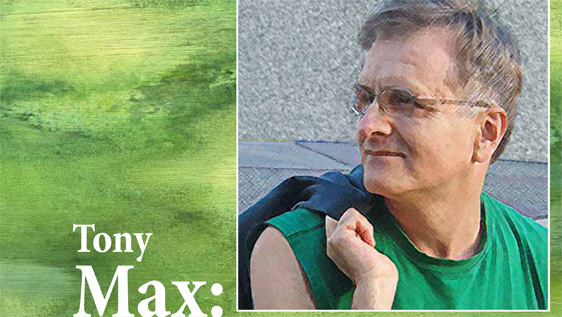By Evra Taylor
 Vancouver artist Tony Max is a renaissance man of the arts. He has crafted a living through a lifetime of artistic endeavours, including writing, graphic design and painting. In fact, Max is so ambitious in continually taking up new artistic pursuits that his efforts sometimes collide in terms of scheduling.
Vancouver artist Tony Max is a renaissance man of the arts. He has crafted a living through a lifetime of artistic endeavours, including writing, graphic design and painting. In fact, Max is so ambitious in continually taking up new artistic pursuits that his efforts sometimes collide in terms of scheduling.
Born and raised inLondon,ON, 54-year-old Max has had open-angle glaucoma since 1989, the unfortunate result of several cataract surgeries he underwent as a teenager in the mid-1970s. At the time, he had 10 percent vision and was considered legally blind. Following the surgery, Max had 20/40 or 20/50 visual acuity, occasionally reaching 20/30, which is his current state. In addition to glaucoma, he has a lazy eye and has had detached retinas three times.
Max underwent life-changing glaucoma surgery at age 13, an event he describes with great emotion. “The moment I got my vision back was very dramatic and I’ll always remember it. When the doctor removed the bandages, what I saw was just amazing. Everything was bright, colourful and full of detail. I innocently said to the doctor, ‘I can see all the lines in your hand!’”
Oddly enough, Max doesn’t know if he was born blind. His doctors contend that his condition was congenital, but his mother disagrees. “I was a premature baby and my mother speculates that my blindness was caused by the intense lights of the incubator.”
Like many handicapped individuals, Max faced discrimination and rejection early in life. As a student, he had to drag his desk to the front of the classroom to see the blackboards, an experience he found very humiliating. “I felt like a freak because I was the only kid in the class with a visual impairment. I was teased a lot. The other students called me ‘batty’. It was extremely traumatizing to be singled out like that.”
As often happens in children with disabilities, Max spent a lot of time on his own as a child, enjoying solitary activities such as drawing, reading and writing. “I think I wanted to be alone because I was ostracized by the other kids at school.”
Sharing an emotional nugget of self-awareness, Max stated, “The isolation of those years made me more sensitive to creative things and objects of beauty. That is what led me to becoming an artist.” Unlike many in the artistic world, who find it difficult to carve out a living, Max has become a success in his chosen field. His artwork is sold in more than 130 Canadian galleries and is collected in 21 countries around the world.
Max is nothing if not eclectic, but most of his interests lie in the artistic realm. After dropping out of fine arts school at Fanshawe College in London,ON, he obtained a degree in journalism, graduating with a BAA (Bachelor of Applied Arts) from the celebrated journalism program at Toronto’s Ryerson University. In the early 1980s, he relocated to Vancouver, where he concentrated on graphic design, founding his own communications firm in 1996.
Until 2002, Max was involved with a cornucopia of projects: writing, editing, proofreading, illustration, graphic design, and communications project management. Then he decided to devote himself to painting. Max creates acrylic paintings and archival, original prints (giclees) primarily depicting Vancouver and southwestern British Columbia, as well as botanical images. While his vision impairment doesn’t affect his work, he couldn’t be a wildlife artist, for example, because it requires fine detail.
Max misses his other pursuits, but like many of us he has had to make hard choices about where to concentrate his energies. “There is simply not enough time to do everything. I’d like to be a musician as well, but those plans are on hold for now because I’m afraid that if I pursue music, I’ll get distracted from my art.”
One theme of Max’s life seems to be moving from art to writing and back again. He claims, however, that he was neither a good artist nor a good writer when he was younger which, he says, shows that one can develop creative talent. “I tell people that the way to get good at being an artist is to devote several thousands of hours to the craft.”
Max’s diverse interests have led him to pursue far-ranging activities such as joining the Editors Association of Canada and volunteering for environmental causes like Sierra Club of Western Canada. His plan for the future is simply to continue what he’s doing. But, in typically ambitious form, he adds that he is interested in digital photography and hopes to find time to get involved in music, as well. “It’s also important to me to support the creative community by educating the public about art and the life of an artist, which I do through my web site,” he explained.
The stalwart artist advises other visually impaired people to be very conscientious about taking their medications and going for medical check-ups as required. In addition, he suggests remaining open to complementary medicines, citing glaucoma studies showing that exercise lowers intraocular pressure. He also pointed to a five-year study on vitamin B12 that demonstrated improved visual fields in glaucoma patients.
Max is equally enthusiastic about the care he has received. He extends heartfelt thanks to the doctors and other medical staff who work in the ophthalmic field. “It is because of them that I have my sight. I would probably be blind if it weren’t for the treatment I’ve received.”
To view Tony Max’s artwork, visit www.tonymax.net.







